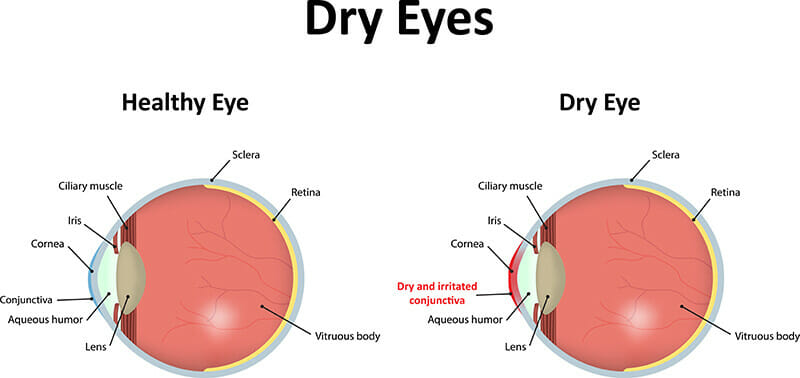The surface of our eyes is protected by our tear film layer, which is a complex mixture of different fluids designed specifically to protect, lubricate, and enhance the capabilities of our eyes. If any component of the tear film is abnormal or compromised, the surface of the eye can become subject to damage from foreign bodies and microorganisms, as well as impaired vision. If this occurs, one may experience irritation, burning sensation, sensitivity to bright lights, excessive tearing or watering, or the feeling of an object in the eye. These symptoms may indicate Dry Eye Syndrome (DES), which is a condition that can cause not only discomfort and poor vision, but can over time cause significant damage to the surface of the eye and leave it susceptible to infection.
In addition to Dry Eye Syndrome, one ocular surface disease that is extremely common is ocular allergies. If our eyes experience an allergic reaction, they can experience irritation, redness, itching, or thick or watery discharge. Because of the similarity between the two conditions, it can at times be difficult to tell if our symptoms are caused by dry eyes or by allergies. Our doctors at Sierra Nevada Eye Center have multiple tests at their disposal to differentiate between the two, in order to provide directed treatment to alleviate or lessen symptoms of Ocular Surface Disease.
Take Our Dry Eye Questionnaire
Testing for Dry Eye Syndrome with TearLab®
In order to properly treat dry eye syndrome, it’s important to measure the volume and quality of your tears. At Sierra Nevada Eye Center, we use TearLab® to diagnose and treat dry eye syndrome. TearLab® is a quick and painless eye test that measures the concentration of fluid in your eyes.
With TearLab® technology, testing for dry eye syndrome is fast, easy and accurate. You won’t feel any pain, and results are almost instantaneous. Your eye doctor can also show you practical images and measurements that help explain dry eye syndrome and its impact on eye health. Many patients find this information invaluable, especially for managing dry eye syndrome at home.
Learn More About Dry Eye Disease and Testing
Treatment Options
Most cases of DES can be simply treated with use of over-the-counter artificial tear solutions. There are many such products available, but preservative free products are recommended more often(certain preservatives can irritate the eye over time). The key in using these drops is to apply them frequently enough to alleviate the problem; once-a-day use will not help in many cases. Other helpful treatments may include regular hydration, a daily supplement of omega 3 fatty acids (fish oil or flaxseed oil), humidifier at home, and wraparound glasses to block out wind and ventilation. Should DES problems persist despite use of artificial tears, then a prescription eye drop like Restasis or Xiidra may be required. Otherwise, our doctor may recommend punctal occlusion. Each eyelid has an opening called the punctum, found on the edge of the lid toward the nose. If the punctum is blocked, then tears remain on the eye surface longer, resulting in better lubrication of the eye. One of our most common DES treatments is punctal occlusion, where a small plug made of silicone or collagen is placed at the punctal opening to block it. Punctal occlusion with a plug is a very quick and simple procedure performed in the office.
If the surface of the eye becomes damaged through trauma, infection, contact lens overwear, severe or chronic ocular surface disease, etc., more advanced treatments may become necessary. A new treatment for such damage, Prokera can heal your cornea and return your eye to a normal, healthy state. Prokera is the only FDA-cleared therapeutic device that reduces inflammation and promotes healing, and is easily inserted and removed in your doctor’s office. Similar to a contact lens and made of amniotic tissue known for its natural therapeutic actions.
What is involved in punctal occlusion?
The tear film system is the eye’s natural plumbing system, whereby tear glands release the tears that bathe the eye; the tears then drain out through the puncta and into the tear duct, which leads to the nose. Each eyelid has an opening called the punctum, found on the edge of the lid towards the nose. If the punctum is blocked, then tears remain on the eye surface longer, resulting in better lubrication of the eye. One of our most common DES treatments is punctal occlusion, whereby a small plug is placed at the punctal opening to block it. Punctal occlusion with a plug is a very quick and simple procedure performed in the office.
For more information about Dry Eye Syndrome, visit the National Eye Institute website.






